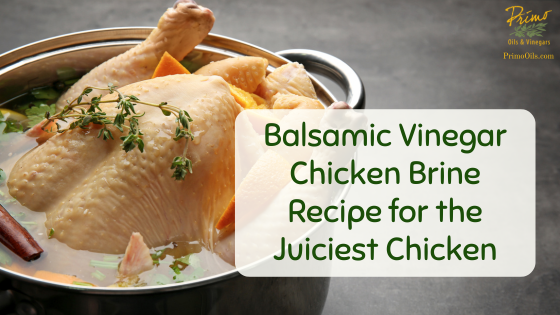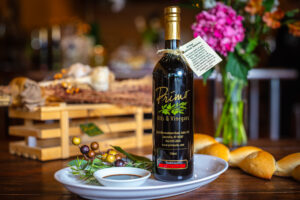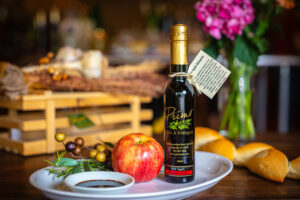This chicken brine literally changed how we all work with chicken in our kitchens. By soaking chicken in a saltwater and balsamic vinegar solution, you can ensure juicy, flavorful results every time. Brining makes chicken tender, juicy, and flavourful, while reducing roasting time by about 20%. And when you use a balsamic vinegar brine, chicken becomes even better. We call this our “change your life chicken brine recipe” for a good reason!
Adding balsamic vinegar to your brine takes it to the next level. This tangy ingredient infuses the meat with a subtle sweetness and complexity. You can experiment with different balsamic varieties like red apple, fig, tangerine, lavender, or pomegranate to create unique flavor profiles.
To make a basic brine, you’ll need 1 tablespoon of salt for every cup of water. Bring the water to a boil, dissolve the salt, then cool it down before adding ¼ cup of balsamic vinegar. Submerge your chicken breasts for at least 30 minutes, and you’re on your way to a delicious meal.
What Is a Chicken Brine?
Chicken brine is a simple yet effective technique to enhance the flavor and juiciness of your poultry.
A chicken brine is a saltwater solution used to soak poultry before cooking. The basic ratio is 1 tablespoon of salt for every cup of water. To make a brine, bring a quart of water to a boil and add kosher salt. Once cooled, you can add your chicken.
The addition of balsamic vinegar brings a unique twist to this classic method. Adding balsamic vinegar to your brine brings a delightful tangy sweetness to your chicken. Use ¼ cup of balsamic vinegar for every quart of brine. This addition not only enhances flavor but also helps tenderize the meat.
For best results, let your chicken soak for at least 30 minutes, but you can brine for up to 24 hours for maximum flavor infusion. The salt in the brine helps the meat retain moisture during cooking, resulting in juicier chicken.
Remember to pat your chicken dry with a clean towel before cooking to ensure a crispy exterior.
Balsamic Vinegar Brine Ideas
You can experiment with different types of balsamic vinegar to create unique flavor profiles:
- Red apple balsamic
- 18-year-old balsamic
- Fig balsamic
- Tangerine balsamic
- Lavender balsamic
- Pomegranate balsamic
Each variety will impart its own distinctive taste to your chicken, allowing you to customize your dishes. Try using spicy brine ingredients like cayenne pepper or paprika for an extra kick in your fried chicken recipes.
Creating Your Balsamic Vinegar Brine for Chicken
A balsamic vinegar brine can elevate your chicken to new levels of flavor and juiciness. This versatile technique allows you to experiment with different ingredients and ratios to create a customized blend that suits your taste preferences.
Selecting Your Ingredients
To create a delicious balsamic vinegar brine, start with high-quality ingredients. Choose kosher salt for its pure flavor and easy dissolution. Opt for filtered water to ensure a clean taste.
For the star ingredient, select a good quality balsamic vinegar. You can use traditional balsamic or explore flavored varieties like red apple, fig, tangerine, lavender, or pomegranate balsamic vinegars. Each will impart a unique flavor profile to your chicken.
Consider adding aromatics like fresh herbs, garlic cloves, or peppercorns to enhance the brine’s complexity. These additional ingredients can complement the rich, sweet-tart notes of the balsamic vinegar.
Balsamic Vinegar Brine Ratios and Measurements
The basic ratio for a balsamic vinegar brine is straightforward. Use 1 tablespoon of salt for every cup of water. For a quart of brine, you’ll need:
- 4 cups water
- 1/4 cup kosher salt
- 1/4 cup balsamic vinegar
To prepare the brine, bring the water to a boil and add the salt, stirring until dissolved. Allow the mixture to cool completely before adding the balsamic vinegar. This cooling step is crucial to prevent partially cooking the chicken.
For best results, brine your chicken for a minimum of 30 minutes. Larger cuts may benefit from longer brining times, up to 12 hours for a whole chicken.
What is the best salt for brine?
The best salt for brining chicken is kosher salt. Its coarse texture and pure, clean flavor make it ideal for dissolving evenly in water and penetrating the meat effectively. Unlike table salt, kosher salt doesn’t contain additives like iodine, which can sometimes affect the taste of the brine. Plus, the larger granules are easier to measure and handle, giving you more control over the salinity of your brine. For a flavorful and juicy chicken, start with kosher salt for your brine—it’s the gold standard in kitchens for a reason.
Customizing Flavors Using Balsamic Vinegar
Balsamic vinegar offers a world of flavor possibilities for your chicken brine. Experiment with different types to create unique taste profiles. Try an 18-year-aged balsamic for a rich, complex flavor or a fruity variety like fig or pomegranate for a sweeter note.
You can adjust the amount of balsamic vinegar to suit your taste. Start with 1/4 cup per quart of water and increase or decrease as desired. Remember, a little goes a long way with balsamic vinegar’s intense flavor.
Consider pairing complementary herbs and spices with your chosen balsamic. Rosemary and thyme work well with traditional balsamic, while citrus zest can enhance fruit-flavored varieties. Don’t be afraid to get creative and develop your signature brine recipe.
How to Brine Chicken with Balsamic Vinegar
Brining is a simple yet effective technique to enhance your chicken’s flavor and juiciness. It involves submerging the meat in a saltwater solution, often with additional flavorings.
Preparation Steps
Start by bringing water to a boil and adding kosher salt. Use 1 tablespoon of salt for every cup of water. Allow the brine to cool completely before use.
For a flavorful twist, add ¼ cup of balsamic vinegar to your cooled brine. This addition brings depth and complexity to your chicken.
Experiment with different balsamic varieties to create unique flavor profiles:
- Red apple balsamic
- 18-year-old balsamic
- Fig balsamic
- Tangerine balsamic
- Lavender balsamic
- Pomegranate balsamic
Place your chicken breasts in the brine, ensuring they’re fully submerged. Use a container large enough to hold both the chicken and the brine comfortably.
Duration and Time Considerations
The brining process requires a minimum of 30 minutes for chicken breasts. However, you can extend this time for more flavor absorption.
For whole chickens, consider brining for 4-12 hours. Larger cuts may benefit from longer brining times, up to 24 hours.
Can you over brine chicken?
You absolutely can! Remember, over-brining can lead to overly salty meat. Stick to recommended times for best results. Never go more than 12 hours with a brine.
After brining, rinse your chicken thoroughly and pat it dry before cooking. This step ensures your dish isn’t too salty.
How to Cook Brined Chicken
Once your chicken has soaked up all the flavorful goodness from the brine, it’s time to prepare it for cooking and serving. The next steps are crucial to ensure your chicken turns out perfectly moist and delicious.
Rinsing and Cooking
After brining, you might wonder if you should rinse the chicken. While some chefs skip this step, rinsing can help remove excess salt and impurities. If you choose to rinse, be sure to pat the chicken dry thoroughly with paper towels.
Next, you’re ready to cook your brined chicken. The cooking method is up to you – grilling, roasting, or frying all work well. Remember, brined chicken cooks faster than non-brined, so keep a close eye on it.
For added flavor, try seasoning your chicken after brining. You can use herbs and spices, but go easy on the salt as the meat has already absorbed some from the brine.
Resting and Serving Suggestions
After cooking, let your chicken rest for 5-10 minutes. This allows the juices to redistribute, ensuring each bite is moist and flavorful.
For serving, consider pairing your chicken with sides that complement the brine flavors. If you used a balsamic vinegar brine, try these pairings:
- Red apple balsamic: Serve with a crisp green salad
- 18-year-old balsamic: Pair with roasted vegetables
- Fig balsamic: Serve alongside a creamy risotto
- Tangerine balsamic: Pair with citrus-infused couscous
- Lavender balsamic: Serve with herb-roasted potatoes
- Pomegranate balsamic: Pair with a wild rice pilaf
Remember, the brine you choose can inspire your entire meal. Get creative and enjoy your perfectly brined and cooked chicken!
Chicken Brine Recipe Questions
Brining chicken enhances flavor and juiciness. The right ingredients, timing, and technique can make all the difference in creating perfectly brined chicken for various cooking methods.
How long should you brine a chicken for the best flavor?
For whole chickens, brine for 8-12 hours. Smaller cuts like breasts or thighs need 2-4 hours. Avoid brining longer than 12 hours to prevent overly salty and mushy texture.
What are the essential ingredients for a simple chicken brine recipe?
The basic ingredients are water and salt. Use 1 tablespoon of salt for every cup of water. Bring a quart of water to a boil, add kosher salt, then cool it down. For extra flavor, add 1/4 cup of balsamic vinegar.
Can you share a chicken brine recipe specifically for grilling?
For grilled chicken, try a brine with balsamic vinegar. After preparing the salt solution, add your choice of balsamic vinegar. Options include red apple, 18-year-old traditional, fig, tangerine, lavender, or pomegranate balsamic.
What’s the best chicken brine recipe for frying?
For crispy fried chicken, use a buttermilk brine. This tenderizes the meat while adding tangy flavor. Mix buttermilk with salt, herbs, and spices of your choice.
Is there a preferred chicken brine formula for smoking?
Smoking chicken benefits from a robust brine. Add aromatic herbs and spices to your salt solution. Consider including garlic, peppercorns, bay leaves, and a touch of brown sugar for depth.
How much salt and sugar is optimal for a flavorful chicken brine?
A good rule of thumb is 1/4 cup of salt per quart of water. If using sugar, add 2 tablespoons per quart. Adjust to taste, but be careful not to oversweeten or oversalt.
Our Favorite Balsamic Vinegars for Brining Chicken
If you’ve made it all the way through this blog we take that as a sign that you’re ready to CHANGE YOUR LIFE with our Change Your Life Balsamic Chicken Brine Recipe. Below are a few of our favorite balsamic vinegars to try. We encourage you to use any flavor that suits your fancy! View our full inventory of balsamic vinegars.









